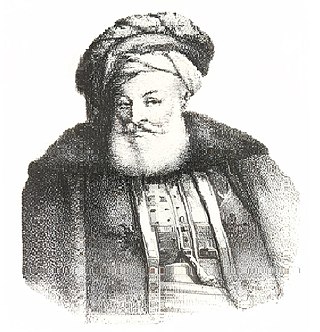Related Research Articles

Dey, from the Turkish honorific title dayı, literally meaning uncle, was the title given to the rulers of the Regency of Algiers (Algeria), Tripoli, and Tunis under the Ottoman Empire from 1671 onwards. Twenty-nine deys held office from the establishment of the deylicate in Algeria until the French conquest in 1830.

The Regency of Algiers was a largely independent tributary state of the Ottoman Empire during the early modern period, located on the Barbary Coast of North Africa from 1516 to 1830. Founded by the corsair brothers Aruj and Hayreddin Barbarossa, the Regency was a formidable pirate base infamous for its corsairs. First ruled by Ottoman regents, it later became a sovereign military republic that plundered and waged maritime holy war against European Christian powers.

Ahmed Bey ben Mohamed Sherif, also known as Ahmed Bey or Hadj Ahmed Bey was the last bey of Constantine in the Regency of Algiers, ruling from 1826 to 1848. He was the successor of Mohamed Menamenni Bey ben Khan. As head of state, he led the local population in a fierce resistance to the French occupation forces. With the position vacant, in 1833 he adopted the title of leader of Algeria, and dey in exile، although this was not recognized by any other country. In 1837 Constantine was taken by the French after an intense siege. He retreated into the Aurès Mountains from where he continued to wage a low-intensity conflict with tribes still loyal to him, until he capitulated in 1848.

The French conquest of Algeria took place between 1830 and 1903. In 1827, an argument between Hussein Dey, the ruler of the Regency of Algiers, and the French consul escalated into a blockade, following which the July Monarchy of France invaded and quickly seized Algiers in 1830, and seized other coastal communities. Amid internal political strife in France, decisions were repeatedly taken to retain control of the territory, and additional military forces were brought in over the following years to quell resistance in the interior of the country.

Mohamed Bey El Mouradi was a Muradid leader and Bey of Tunis from 1675 until his death in 1696. He was the eldest son of Murad II Bey.

The Kingdom of the Ait Abbas or Sultanate of the Beni Abbas was a Kabyle, Berber state of North Africa, then a fief and a principality, controlling Lesser Kabylie and its surroundings from the sixteenth century to the nineteenth century. It is referred to in the Spanish historiography as "reino de Labes"; sometimes more commonly referred to by its ruling family, the Mokrani, in Berber At Muqran. Its capital was the Kalâa of Ait Abbas, an impregnable citadel in the Biban mountain range.

The Revolutions of Tunis or the Muradid War of Succession was a period of troubles and civil wars in Ottoman Tunisia. It ran from the death of the Muradid sovereign Murad II Bey in 1675 until the seizure of power by the Husainid sovereign Al-Husayn I ibn Ali at-Turki in 1705. The belligerents were Ali Bey al-Muradi and Muhammad Bey al-Muradi, their uncle Muhammad al-Hafsi al-Muradi, several Deys of Tunis, the Turkish militia in Tunis and the Dey of Algiers.
The first Médéa expedition, also known as the Atlas expedition of 1830 was a military expedition conducted by the Kingdom of France against the remnants of the Deylik of Algiers, the Beylik of Titteri and the local resistance led by Mohamed ben Zaamoum. It began on 17 November 1830 and ended eight in early December.
The Dey of Tunis was the military commander of the janissaries in the regency of Tunis. In the seventeenth century the holders of the position exercised varying degrees of power, often near-absolute. Until 1591 the Dey was appointed by the Ottoman governor (“Pasha”). In 1673 the Dey and the janissaries revolted against Murad II Bey and were defeated. After this the hereditary position of Bey was pre-eminent in Tunis. The position of Dey continued to exist until it was abolished by Sadok Bey in 1860.

Baba Ali Chaouch, also known as Ali Soukali, or simply Ali I, was a ruler of the Deylik of Algiers from 1710 to 1718. He was the first dey of Algiers to be invested with the title of dey-pacha. The Sultan Ahmed III had Ali Chaouch's envoy given the caftan and the three tails, a sign of the dignity of a "pasha". This title was attributed to all his successors until 1830.

The Beylik of Constantine, Beylik of the Sunrise or Beylik of the East as was its official designation, was one of the three Beyliks of the Regency of Algiers . The region liberated itself from the Hafsid Emirate of Béjaïa in the early 16th century, and constituted itself around Constantine in the mid to late 16th century. The Beylik collapsed in the 1837 siege of Constantine during the French conquest of Algeria. The Constantine department was formed upon the bases of the Beylik in 1848.

The Tunisian–Algerian war of 1694 was a conflict between the Deylik of Algiers, and the Regency of Tunis.
The Maghrebi war (1699–1702) was a conflict involving a Tunisian, Tripolitanian, and Moroccan coalition, and the Deylik of Algiers. It was an important milestone in the further weakening of the already fragile Ottoman grip over the Maghreb, as both sides utterly ignored the Ottoman sultan's pleas to sign a peace treaty. This war also led to the renewal of the Muradid infighting, which would later lead to the establishment of the Beylik of Tunis, and the Husainid dynasty in 1705.
The siege of Tunis was a siege fought in 1694, between the Deylik of Algiers, and Muradid Tunis, during the Tunisian-Algerian War of 1694.
The Constantine campaign was launched by Bey of Tunis Murad III Bey in 1699 to capture the Beylik of Constantine, situated in the east of the Deylik of Algiers.
The Battle of Jouami' al-Ulama took place on 3 October 1700 near Sétif, Algeria. It was fought between the armies of the Bey of Tunis Murad III and those of the Deylik of Algiers commanded by the Dey Hadj Mustapha, and a newly elected Bey of Constantine, Ahmed ben Ferhat.

The Beylik of Titteri,, was one of the three permanent Beyliks of the Regency of Algiers, the other two being the Western Beylik, and the Beylik of Constantine. It was established in 1546 and was ended during the French conquest of Algeria.
The Capture of Tunis was a military operation led by the Bey of Constantine during which he seized Tunis and made the Beylik of Tunis a tributary of Algiers.
The Tunisian–Algerian War of 1705 was a conflict between the Regency of Algiers and the Regency of Tunis.
References
- ↑ Cheurfi, Achour (2007), "Brahem Critli Bey a été bey de Constantine", Dictionnaire encyclopédique de l'Algérie, Editions ANEP.
- "بايات الشرق في الجزائر" . Retrieved October 3, 2012.
- Abdeljelil Temimi (1978). Le Beylik de Constantine et Ḥād̲j ʻAḥmed Bey (1830-1837), Revue d'histoire maghrébine. CH I. p. 90.
{{cite book}}: CS1 maint: location missing publisher (link) - Henri Jean François Edmond Pellissier de Reynaud (1836). Annales Algériennes. Paris: Anselin et Gaultier-Laguionie. pp. vol II, p. 384–385.